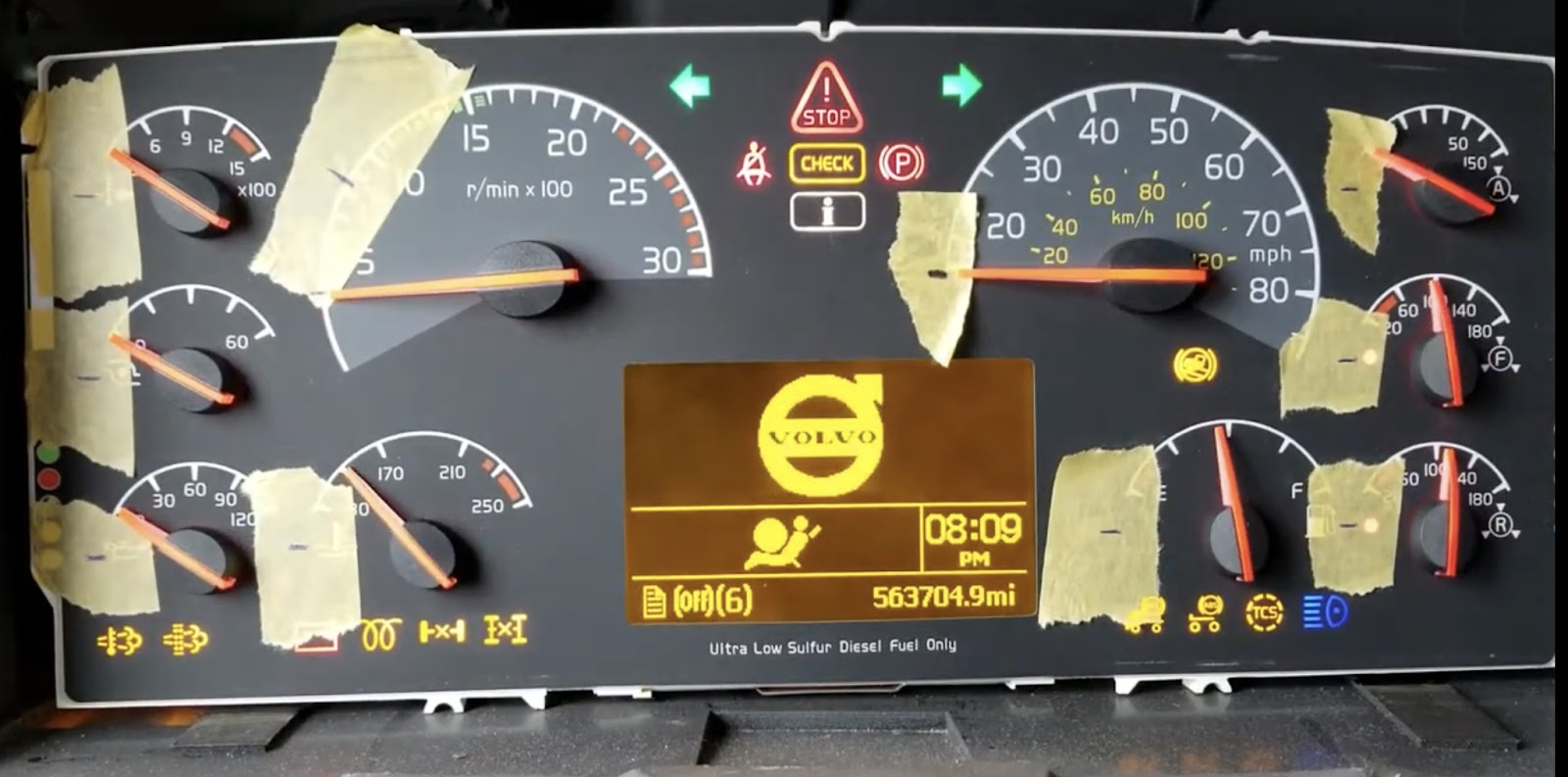In the world of Volvo truck drivers, a wealth of information awaits them on their dashboards. For those new to driving a Volvo truck, the array of gauges and their meanings can be overwhelming. However, this blog post will serve as a guide, exploring the different Volvo truck dashboard gauges and their significance. Armed with this knowledge, drivers can stay informed while cruising the roads, vigilantly monitoring their truck’s crucial aspects.
The gauges on a Volvo truck’s dashboard are crucial for keeping track of its performance and status. Each gauge has its meaning. The speedometer is the gauge showing the current speed of the truck. At the time the tachometer indicates how fast the engine is running, giving us insight into its workload. It’s important to keep an eye on the coolant temperature gauge as it tells us if the engine is overheating. The oil pressure gauge lets us know if there’s pressure in the oil system. When it comes to managing fuel we rely on the fuel level gauge to let us know how much fuel is left in the tank. We also check the voltmeter to make sure our battery has voltage, for a smooth start and operation. Finally we have an odometer that keeps track of how miles we’ve driven, helping us monitor our progress and distance traveled along our journey.
Essential Meanings of Volvo Truck Dashboard Gauges
Several Volvo truck dashboard gauges carry utmost importance for drivers to comprehend. First and foremost is the speedometer, an unequivocal gauge for monitoring velocity. Following that, the tachometer takes center stage, providing a clear view of the engine’s RPMs. The fuel gauge comes into play, indicating the remaining fuel level, and lastly, the coolant temperature gauge helps keep a close eye on the engine’s temperature.
The Causes Behind Non-Functional Volvo Truck Dashboard Gauges
A myriad of factors can be responsible for Volvo truck dashboard gauges ceasing to function. Among the most common culprits is a low truck battery, necessitating recharging. Additionally, problems in the truck’s electrical system can lead to gauge malfunction. If the gauges remain active while the truck is running, it may signify an issue with the alternator. Conversely, gauges failing to work after turning off the engine could indicate trouble with the truck’s ignition system.

Utilizing the Volvo Truck Dashboard Gauges Effectively
The Volvo truck dashboard gauges play a pivotal role in providing crucial information about the truck’s performance and condition. Among these gauges, the speedometer, tachometer, and fuel gauge are of paramount importance.
- To make the most of the speedometer, drivers must keep an eye on the needle’s position, ensuring it remains within the green zone, adhering to or staying below the posted speed limit. The tachometer’s ideal range, in most driving situations, lies between 1,500 and 2,000 RPMs. Crossing into the red zone indicates engine strain, necessitating prompt action to avoid potential damage;
- Meanwhile, the fuel gauge merits consistent attention to track fuel levels accurately. A needle in the red zone signals a need to refuel urgently, as only a few gallons remain in the tank.
Understanding each gauge is vital in maintaining a smoothly running and safe Volvo truck. This guide has provided an overview of the various Volvo truck dashboard gauges and their meanings. By acquainting themselves with these gauges, drivers can ensure their Volvo trucks perform at their best during their time behind the wheel.
Conclusion
Volvo truck drivers possess a wealth of information at their fingertips through the dashboard gauges. While initially overwhelming for newcomers, understanding the significance of each gauge is crucial for ensuring a safe and efficient journey on the road. The speedometer, tachometer, fuel gauge, coolant temperature gauge, oil pressure gauge, voltmeter, and odometer all contribute vital details about the truck’s performance and status.
- Drivers should pay particular attention to the speedometer, tachometer, and fuel gauge, as they are the most essential gauges for maintaining optimal driving conditions. The speedometer keeps drivers informed about their speed, the tachometer monitors engine RPMs, and the fuel gauge alerts them to the remaining fuel in the tank;
- Furthermore, understanding the causes behind non-functional gauges is essential for quick troubleshooting. Low truck battery, electrical system problems, and issues with the alternator or ignition system can all lead to gauge malfunctions;
- By effectively using the dashboard gauges, drivers can ensure their Volvo trucks run smoothly and safely. Monitoring speed, RPMs, and fuel levels allows them to respond promptly to any issues and maintain their truck’s peak performance.
In conclusion, armed with knowledge about Volvo truck dashboard gauges and their meanings, drivers can confidently hit the road, knowing they have the necessary information to make informed decisions while driving their Volvo trucks. So, the next time you step behind the wheel of a Volvo truck, take a moment to familiarize yourself with these essential gauges, ensuring a safe and successful journey ahead.
